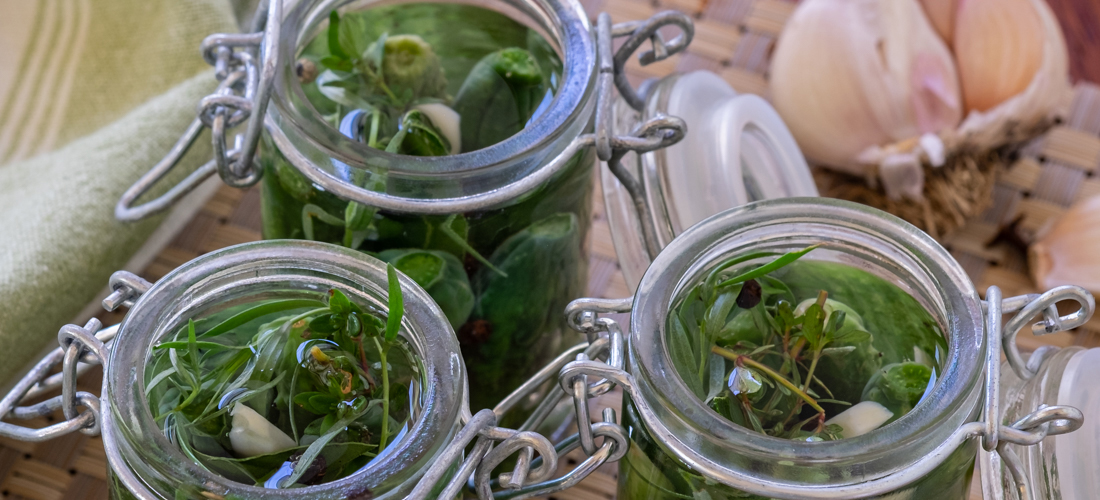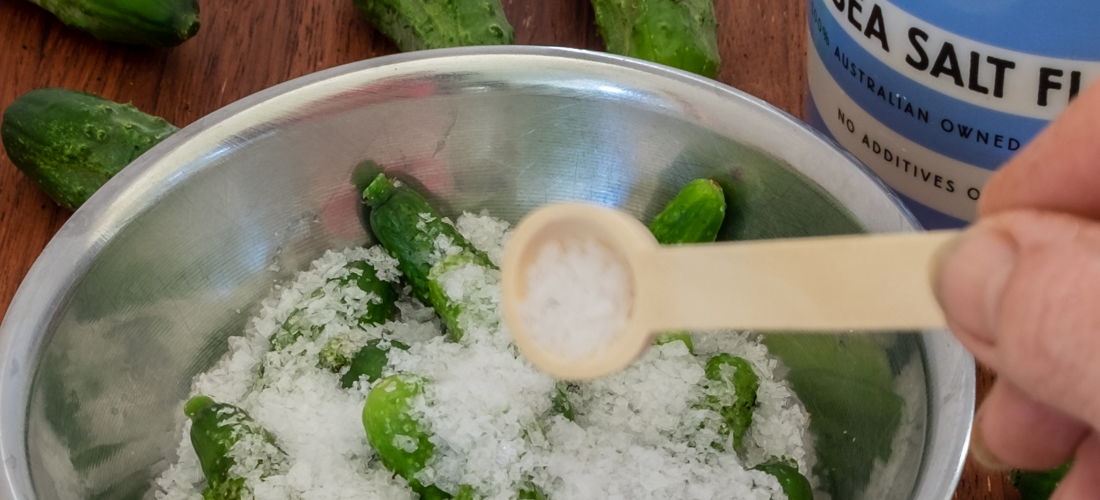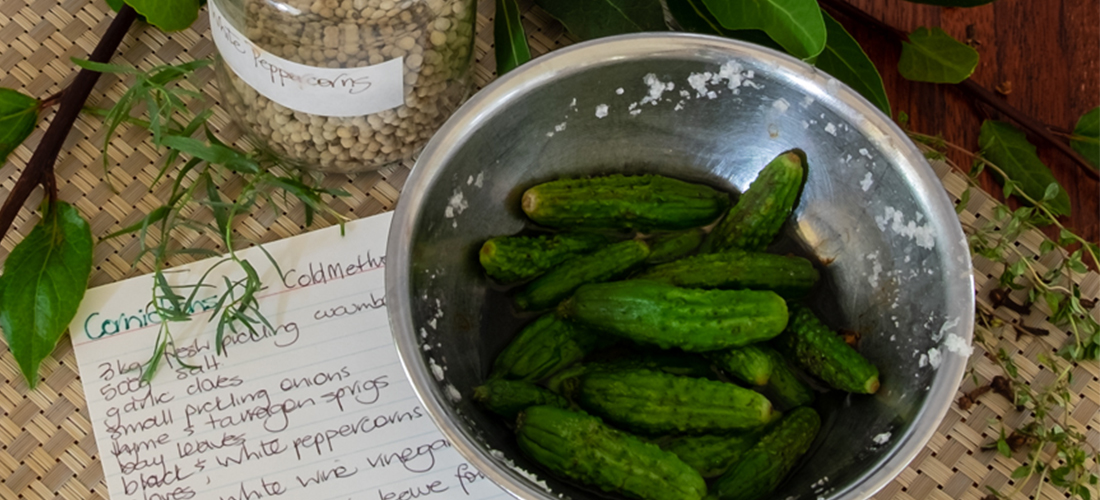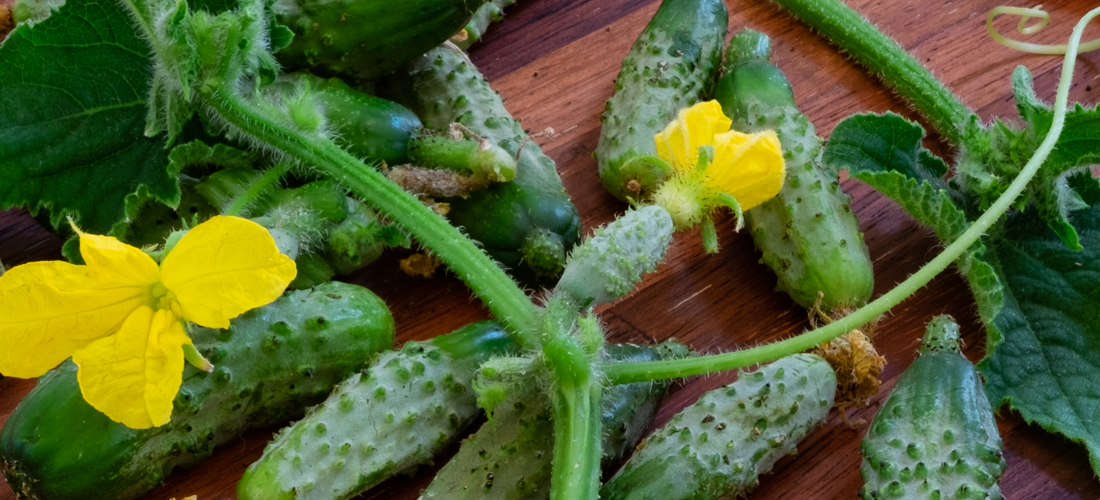Cornichons by the Cold Method
- Pickles, Chutney, Relish & Sauces

For this classic French pickle, known as Cornichons au Vinaigre (à Cru), harvest very small pickling cucumbers and process them within three days of picking. This method is a very quick and easy fresh pickle as it is not fermented or cooked: rather its preserved by the acid content in the undiluted vinegar. It produces a strong sharp pickle that’s the perfect accompaniment to pate, terrine, pickled and smoked products and an essential ingredient in another French classic – gribiche sauce. This is a must-do recipe for all kitchen gardeners and cooks.
- Preparation Time:
- 30 minutes plus overnight salting
- Cooking Time:
- 10 minutes
- Quantity:
- 2 x250 ml jars
PREPARATION
Sterilise sealable glass jars with non-reactive lids

INGREDIENTS
- 150g
- Small pickling cucumbers , 2-3 cm
- 25g
- Preserving salt
- 450 ml
- White wine vinegar
- 1/2 teaspoon
- Black peppercorns, whole
- 1/2 teaspoon
- White peppercorns, whole
- 1/2 teaspoon
- Cloves, whole
- 2
- Bay leaves
- 4-6
- Thyme sprigs, fresh
- 4-6
- Tarragon sprigs, fresh
- 3
- Garlic cloves, peeled

METHOD
My top three tips to preserving the perfect crisp sharp cornichon; (1) pickle on harvest day, (2) use preserving salt not table salt and (3) use a good quality naturally fermented white wine vinegar.
Remove the flower and gently wash the cucumbers thoroughly to remove any garden debris and the spiky hairs on the skin. Dry lightly with paper towel or a clean dry tea towel.
Place in a stainless steel or earthenware bowl and sprinkle with salt, cover and leave overnight. Turn frequently. After one day the cucumbers will be limp and flexible as any excess moisture has been removed.
Next day drain off the salty liquid and wipe off any remaining salt.
Place cucumbers into sterilised jars and add to each some sliced peeled garlic, 2-3 black and white peppercorns, a sprig of thyme and tarragon, and bay leaf.
Cover the cucumbers completely with vinegar, leaving 1.25centimeters (½ inch) from the top of the jar.
Seal, label and store in a cool dark place in the kitchen or pantry.
Allow to mature for at least 5 weeks before eating.
After opening, store in the refrigerator and use within 12 months.
NOTES
- Unless you have access to large quantities of small pickling cucumbers, it’s likely you will be preserving in small batches. If you are growing your own, harvest the cucumbers in the cool of the morning and place in the crisper compartment of your fridge. Process within 2-3 days.– any longer and they will begin to dehydrate, and the final product will be compromised.
- Use pickling salt, not table salt or coloured mineral or sea salts as they can change the colour, clarity, and taste in the case of the coloured salt. It may be difficult to finds the right salt but the result is well worth it.
- Table salt contains stabilisers and anti-caking agents and often iodide which forms a whitish haze and sediment. These additives and in particular iodine can affect the appearance and taste of pickles and during the maturation and storage period. The ingestion of a cocktail of anti-caking chemicals such as calcium silicate, sodium silicoaluminate, tricalcium phosphate, magnesium carbonate, silicon dioxide and yellow prussate of soda, is also unnecessary.
- Lite Salt may be used in quick pickle recipes; however, it may result in a slightly different taste than expected.
- Caution: Use of reduced-sodium salt in fermented pickle recipes is not recommended. The salt creates a favourable environment for the growth of harmful bacteria while retarding in the growth of beneficial bacteria. The correct concentration of salt is vital to texture and food safety.
- Coloured salts, green, black, pink, and red can contain impurities that can adversely affect the pickling process.
- The amount of thyme, tarragon, peppercorns, garlic, cloves, and bay leaf can be increased or decreased according to taste. When preserving greater quantities in larger jars increase the flavourings accordingly.
- This is often referred to as a fresh pickle as it is not fermented or cooked. It’s preserved by the acid content of the undiluted vinegar. Use jars with non-reactive lids as the acid content in the vinegar will cause a metal lid to corrode over time.
- When labelling, note when the cornichons will be ready to eat. This nifty trick provides a ready reference of when you can break into the jars and enjoy your own homemade cornichons.

